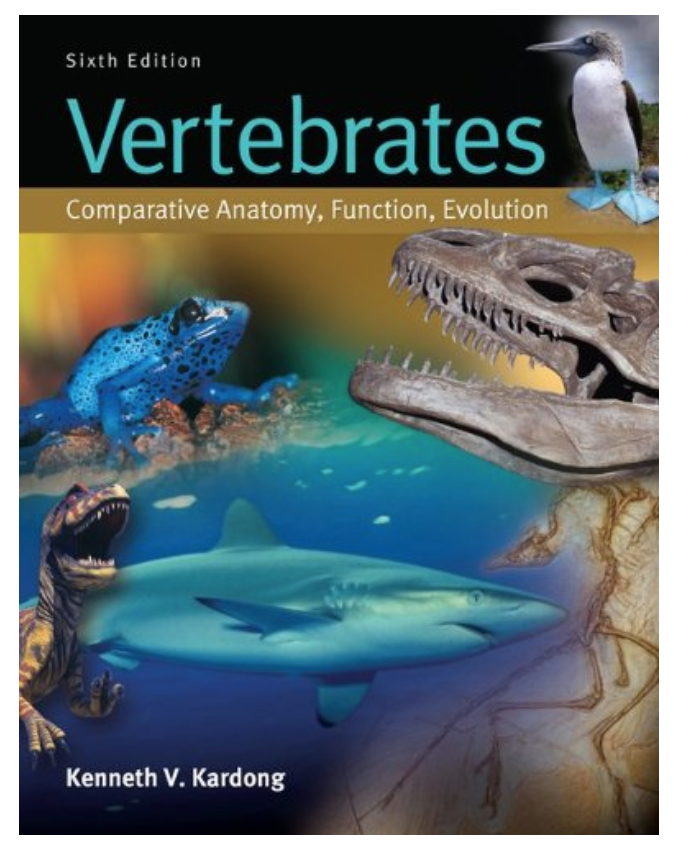
Each of you is different. That means many things, but in the context of learning, it means that having variety in our assignments is important to ensure everyone is supported and challenged. That is at the core of the design of this course.
For each module in Blackboard you will find,
- Learning objectives, which define the new knowledge and skills you will acquire
- Content, which will be comprised of readings and videos
- Assignments, which will be comprised of discussions, and quizzes.
Module Content

You will not have to purchase a textbook in this class (yay!). But there is content in each module you are expected to read, watch, and engage in. Our primary text will be Vertebrates – Comparative Anatomy, Function, Evolution, Kenneth V. Kardong, Ph.D., McGraw-Hill, New York. Lab exercises will be supplied via the Comparative Anatomy Lab Manual, which is available at no cost within your Bb course. You will be learning online in Bb and attending labs in person on Thursdays, from 12:40 PM – 4:00 PM and will use the lab equipment on campus.
Lecture Topics and Sequence
This section contains the list of lecture topics by week and the textbook readings for each by chapter.
LECTURE TOPICS AND SEQUENCE
| Week | Topic(s) | Textbook Reading |
| 1 | Introduction Chordates | Chapters 1 & 2 |
| 2 | The Vertebrate Story Biological Design | Chapters 3 & 4 |
| 3 | Life History Integument | Chapters 5 & 6 |
| 4 | The Skeletal System: The Skull The Skeletal System: The Axial Skeleton | Chapters 7 & 8 |
| 5 | The Skeletal System: The Appendicular Skeleton | Chapter 9 |
| 6 | The Muscular System | Chapter 10 |
| 7 | The Respiratory System | Chapter 11 |
| 8 | The Circulatory System | Chapter 12 |
| 9 | The Digestive System | Chapter 13 |
| 10 | The Urogenital System | Chapter 14 |
| 11 | The Endocrine System | Chapter 15 |
| 12 | The Nervous System Sense Organs | Chapters 16 & 17 |
Laboratory Topics and Sequence
This section contains the laboratory topics by week and the corresponding laboratory exercises for each. The entire Lab Manual may be found on our Blackboard course site under “Start Here and Course Information”. The laboratory exercise(s) for each week can also be found in the corresponding weekly content folder on Blackboard site (ex. Week 1, Week 2, etc.).
| Week | Topic(s) | Laboratory Exercises |
| 1 | Amphioxus Anatomy Lamprey Anatomy | Amphioxus Dissection Lamprey Dissection |
| 2 | Dogfish Shark External Anatomy & Integument Skeletal System Muscular System | Shark Dissection 1 Shark Dissection 2 Shark Dissection 3 |
| 3 | Dogfish Shark – continued Internal Anatomy | Shark Dissection 4 |
| 4 | Dogfish Shark – continued Internal Anatomy | Shark Dissection 4 |
| 5 | Perch | Perch Dissection |
| 6 | Necturus (Mud Puppy) External Anatomy & Integumentary System Skeletal System Muscular System Internal Anatomy | Necturus 1 Dissection Necturus 2 Dissection Necturus 3 Dissection Necturus 4 Dissection |
| 7 | Reptiles – Turtle | Turtle Dissection |
| 8 | Cat External Anatomy & Integumentary System Skeletal System | Cat 1 Dissection Cat 2 Dissection |
| 9 | Cat – continued Muscular System | Cat 3 Dissection |
| 10 | Cat – continued Internal Anatomy | Cat 4 Dissection |
| 11 | Topic: Cat – continued Internal Anatomy | Cat 4 Dissection |
| 12 | Research Project/Lab Wrap Up |
Notes:
- Comparative anatomy is an in depth study of the features common to vertebrates. The organ systems of these animals will be studied with an evolutionary theme to show the gradual trend toward greater complexity and more specialization in higher vertebrates.
- In this course you will dissect several representative vertebrate animals as your studies take you from the simple to the more complex organisms.
- Dissection is an art that allows us to learn and takes patience and practice.
- All students are strongly encouraged to read each assignment and lab carefully, take accurate and complete notes, and ask questions.
- Comparative anatomy is an exciting learning journey. Enjoy it!
Student Learning Objectives – Lecture and Lab
Student Objectives – Lecture
Below you will find objectives to help guide you in your reading and studying of the material for each lecture textbook chapter. These are here to help you with the material.
Ch. 1 – Introduction
- Define anatomy and physiology and distinguish between the two.
- Define comparative anatomy.
- List the distinguishing characteristics of chordates and vertebrates.
- Discuss historical aspects of the field of comparative anatomy and key individuals who played a role in its formation.
- Define morphological terms (symmetry, segmentation, etc.) and provide examples of each.
- Define and describe phylogeny.
- Interpret and use a cladogram.
- Define paleontology.
- Examine the fossil record.
Ch.2 – Origin of Chordates
- State the characteristics of Protochordates (Hemichordates and Urochordates)
Ch.3 – The Vertebrate Story
- Outline the vertebrate groups (Agnathans, Gnathostomes, Teleostomi, Tetrapods, Amniotes).
- Distinguish the vertebrate groups using their unique characteristics.
Ch.4 – Biological Design
- Examine the sizes and shapes associated with vertebrates.
- Study the basic principles of Biomechanics and Biophysics (ex. velocity, acceleration, force, diffusion, exchange) and how these principles are applied to vertebrate organisms.
Ch.5 – Life History
- Examine the embryological development of vertebrate organisms (fertilization, cleavage, gastrulation, neurulation).
- Study organogenesis and tissue development in vertebrates (epithelial, connective, neural).
- Explain the development of the coelom.
- Study maturation in vertebrates.
- Distinguish between Ontogeny and Phylogeny, and the Biogenetic Laws associated with each.
Ch. 6 – Integument
- List and discuss the general features of the Integument (Epidermis and Dermis) in vertebrates.
- Discuss the phylogeny of Integument in fish, amphibians, retiles, birds and mammals.
- Discuss the specializations of the Integument (nails, claws, hooves, horns, antlers, baleen, scales, armor, mucus, color, etc.).
Ch. 7 – Skeletal System: The Skull
- Discuss and distinguish between the Chondocranium, Splanchnocraniun and Dermatocranium.
- Provide an overview of skull morphology.
- Discuss phylogeny of the skull in agnathans and gnathostomes.
- Provide an overview of skull function and design.
Ch. 8 – Skeletal System: The Axial Skeleton
- List and describe the basic components of the Axial Skeleton (vertebrae, ribs, sternum, gastralia).
- Discuss the embryonic development of the axial skeleton in fishes and tetrapods.
- Discuss the phylogeny of the axial skeleton in fishes and tetrapods.
- Discuss mechanical design considerations in the vertebrate axial skeleton.
Ch. 9 – Skeletal System: The Appendicular Skeleton
- List and discuss the basic components of the appendicular skeleton (fins, limbs).
- Discuss the origin of paired fins.
- Discuss the phylogeny of the vertebrate appendicular skeleton in fishes and tetrapods.
- Discuss the evolution of the appendicular skeleton.
- Discuss mechanical design considerations in the vertebrate appendicular skeleton (swimming, terrestrial locomotion, flight).
Ch. 10 – The Muscular System
- List and describe the types and structure of muscle.
- Describe basic muscle contraction on a microscopic and molecular level.
- Discuss muscle mechanics in terms of length, tension, force, shortening and action.
- Describe the embryonic origin of muscles.
- Compare the anatomy of muscles across the vertebrates.
Ch. 11 – The Respiratory System
- List and describe the vertebrate respiratory organs.
- Explain ventilatory mechanisms.
- Compare respiratory systems across the vertebrates.
- Discuss gas exchange, including breathing in air and water.
- Discuss the evolution of respiratory organs.
Ch. 12 – The Circulatory System
- List and describe the components of the vertebrate circulatory system (blood, vessels, heart).
- Distinguish between single and double circulation.
- Describe the embryonic development of the cardiovascular system.
- Compare blood vessels across the vertebrates.
- Compare hearts across the vertebrates.
- Discuss cardiovascular system specialized adaptations (fetal, placental, etc.) across vertebrates.
- List and describe the components of vertebrate lymphatic systems.
- Discuss the form and function of vertebrate lymphatic systems.
Ch. 13 – The Digestive System
- List and describe the components of the vertebrate digestive system, including accessory organs.
- Describe the function and evolution of the vertebrate digestive system.
Ch. 14 – The Urogenital System
- List and discuss the components of the vertebrate urinary system.
- Describe in detail the structure and function of kidneys across the vertebrates.
- Discuss the evolution of the vertebrate urinary system.
- Describe the structure of the mammalian reproductive system.
- Discuss the embryonic development of the vertebrate reproductive system.
- Describe the reproductive tracts of vertebrates.
- List and describe the components of female reproductive systems in vertebrates.
- List and describe the components of male reproductive systems in vertebrates.
- Compare external and internal fertilization across the vertebrates.
Ch. 15 – The Endocrine System
- List and describe the organs of the endocrine system in vertebrates.
- Discuss the phylogeny of endocrine organs in vertebrates.
- Discuss the evolution of the endocrine system in vertebrates.
Ch. 16 – The Nervous System
- List and discuss the types of cells in the vertebrate nervous system.
- List and discuss the components of the vertebrate peripheral nervous system.
- Discuss the functions of the vertebrate peripheral nervous system.
- List and discuss the components of the central nervous system in vertebrates.
- Discuss the functions of the central nervous system in vertebrates.
Ch. 17 – Sensory Organs
- List and discuss the components of a sensory organ in vertebrates.
- List and discuss general and special sensory organs in vertebrates.
Student Objectives – Laboratory
The objectives below are intended to help guide you as you work through each dissection in lab.
- List and demonstrate laboratory safety procedures.
- Identify components of Amphioxus anatomy.
- Identify components of Lamprey external anatomy.
- Virtually dissect and identify internal anatomical structures of the Lamprey.
- Identify components of Dogfish shark external anatomy.
- Virtually dissect the Dogfish shark; identify internal components of the integumentary, skeletal, muscular, digestive, respiratory, urogenital, circulatory, lymphatic, nervous & endocrine systems.
- Identify components of external Perch anatomy.
- Virtually dissect the Perch and identify internal anatomical components.
- Identify external anatomical components of Necturus (Mud Puppy).
- Virtually dissect Necturus; identify components of the integumentary, skeletal, muscular, digestive, respiratory, urogenital, circulatory, lymphatic, nervous & endocrine systems.
- Identify external anatomical components of a Turtle.
- Virtually dissect a Turtle and identify components of the integumentary, skeletal, muscular, digestive, respiratory, urogenital, circulatory, lymphatic, nervous & endocrine systems.
- Identify external anatomical and skeletal components of Birds.
- Identify external anatomical components of the Cat.
- Virtually dissect the Cat and identify components of its integumentary, skeletal, muscular, digestive, respiratory, urogenital, circulatory, lymphatic, nervous & endocrine systems.
- Compare the anatomical features of Amphioxus, Lamprey, Dogfish Shark, Perch, Necturus (Mud Puppy), Reptiles, Birds and Cat.
- Participate in a class research project, report findings in the form of a written lab report.




